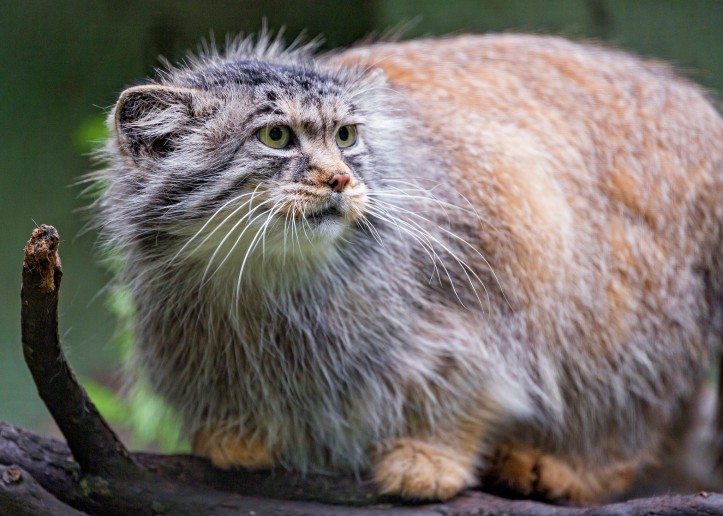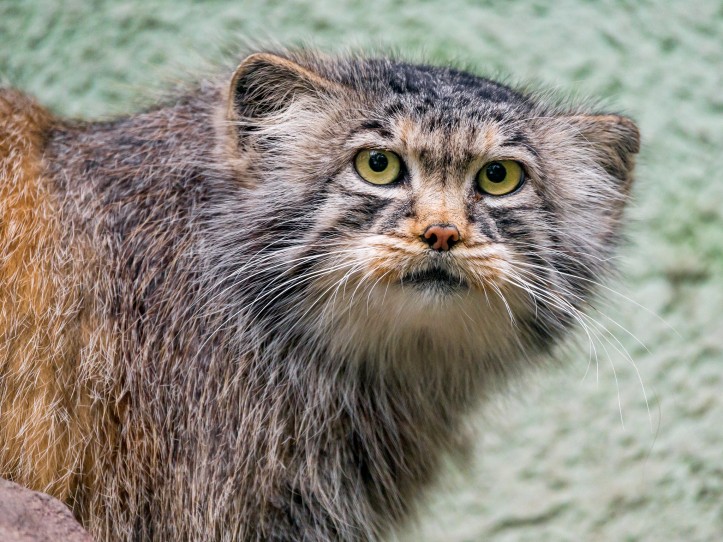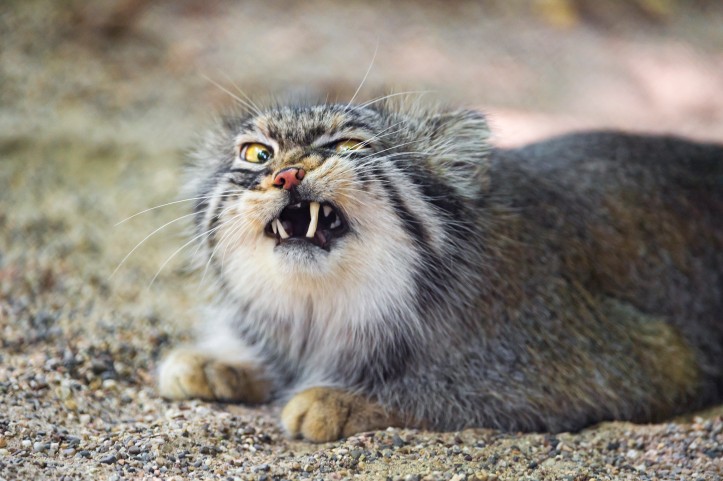Pop quiz:
You’re a cat living on an arid, high-altitude plain, with just some tiny plants and a few rocks to use as cover. Your prey has sharp eyes and can spot you miles away on this open ground What do you do to survive?
Answer:
You become small (if you weren’t already) and you grow a thick fur coat that warms you and also blends in surprisingly well with your surroundings.

Tambako the Jaguar, CC BY-ND 2.0.
You evolve a flattish face and head, downsizing your big ears and dropping them down low on your head — about even with your eyes — so they won’t stick up like little flags saying “CAT HERE!”.
You also evolve lots of lines and dots and white spaces on your facial fur to break up the outline of your head, misleading prey into thinking that you’re a rock as you peek around one during the stalk.

“What?” (Image: Tambako the Jaguar, CC BY-ND 2.0.
And you get flat, very flat, as in “being one with the ground itself.”
All that evolutionary work, just for H. sapiens to call you a grouchy cat!

“What? You don’t laugh at lions roaring or deer butting antlers. Why is how I defend my territory from other cats so funny?” — Pallas cat. (Image: Tambako the Jaguar, CC BY-ND 2.0)
Not that you care very much about what H. sapiens thinks because, first of all you’re a cat, and secondly, you’re a Pallas cat, a/k/a manul.
All of these evolutionary tricks do keep you alive and well in some of the harshest landscapes on the planet.
A cat’s gotta do what a cat’s gotta do.
But let’s not judge a furry face by its funky frowns alone!
46. Captive Pallas cats are friendly.
Just for the record, Grumpy Cat (of Internet fame) was a domestic shorthair born with an underbite and feline dwarfism that gave her a disgruntled appearance even though she behaved like the normal house cat she otherwise was.
A photographer caught a Pallas cat when it was being territorial, raising and lowering its lip fast, exposing one fang as if to say, “I’ve got plenty more where this comes from!” — a move that probably intimidates other Pallas cats when they’re challenging each other out on the steppe — and the “Grouchy Cat” meme was born.
It gives us a lot of fun even though Pallas cats actually are quite mellow and friendly in zoos.
Like other wild cats, they get moody, and their unusual looks can be framed by a camera in ways that make them appear grouchy —
Or downright insane.
— but that’s not their reality.
This is:
And this:
In zoos. Out in the wild —
47. Manul risks its life to hunt.
Everyone knows that the patterns on a wild cat’s coat are for camouflage. But did you know that smaller cats don’t use this just to conceal themselves from prey?
Small cats also need to avoid becoming prey themselves. Predators that are hunting them include wolves, cats larger than themselves, and even owls, hawks, and eagles.
That is not problematical for, say, a Siberian tiger, but little Manul without a camouflage coat would be a sitting target while waiting in ambush or else moving very, very slowly during a stalk.
Another problem — cover is scarce in Pallas cat country.
Only the size of a house cat, Pallas cats must constantly watch out for danger even as they sneak up — out in the open! — on a rodent or other small prey.
In steppe country, trouble might take the form of dogs or birds of prey. There is a wider assortment of manul-eaters in places like the Himalayas, where bears, wolves, lynx, and other cats prowl.
In such a dangerous world, Pallas cats stay indoors as much as possible.
They can’t dig, but they can and do live in abandoned marmot burrows, as well as in rocky crevices and any other protected space they can find.
Sooner or later, though, they must hunt, facing the double challenge of getting food and trying not to become someone else’s food.
Upon sensing a threat, little Manul freezes, flat on the ground — and disappears. Its furry camouflage is that good!
When captive Pallas cats do this, according to Sunquist and Sunquist, zookeepers can have a hard time seeing them even when they know where the cat is.
Want to try it yourself?
Just go to the Habitat section of the Cat Specialist Group Pallas cat page and check out this image by S. Ross (labeled “Pallas’s cat hiding in the rocks, Hustai Nurru buffer zone, Mongolia”).
Clever kitty!
48. Pallas cats would not make good house pets.
Why not? Zookeepers say that they are friendly and gentle.
Yes — in a zoo, when handled by people who are trained to see wild animals as they really are and to keep both the animals and the human world around them happy and safe.
Without that training. like the rest of us, they would see Manul as another kind of domestic cat. It’s the right size, and, oh, so floofy!
But it is not a housecat, and it does not have behind it the thousands of years of human work that have gone into domesticating cats.
Not that I have personal experience to share, but based on accounts of what cat breeders go through when bringing a jungle cat or leopard cat into their Chausie and Bengal programs, respectively, I’d say that even the tamest Pallas cat would be a handful to manage at home.
And then there are the feeding issues, waste management issues, healthcare issues (for example, toxoplasmosis often kills captive Pallas cats), socialization issues, spraying, and other problems that were bred out of the African wildcat down through the millennia as it slowly became domesticated.
On a closing note, we humans sometimes do nice things for wild Pallas cats while letting them stay wild.
And a few people have hearts as big as the Himalayas.
You and I might willingly surrender couch and bed space to our beloved Fluffy, but how many of us would loan our house to a wild cat?
Potential pet owners can always go down to the zoo and enjoy the Pallas cat exhibit, and then perhaps, on our way home, stop in at a shelter and adopt one of the many domestic cats in need of a forever home.
They might not have the mesmerizing eyes of Manul, but they can feel and return your love — something no wild animal can ever really do completely.
If you enjoyed the series, tips are welcome via the secure Stripe donation link. I won’t be saving your email for marketing or other spam, so here’s a big thank you in advance!
Sources include:
Barashkova, A.; Smelansky, I.; Kirilyuk, V.; Naidenko, S.; and others. 2019. Distribution and status of the manul. Cat News, Special Issue 13. http://www.catsg.org/index.php?id=711
Brown, M.; Lappin, M. R.; Brown, J. L.; Munkhtsog, B.; and Swanson, W. F. 2005. Exploring the ecologic basis for extreme susceptibility of Pallas cats (Otocolobus manul) to fatal toxoplasmosis. Journal of Wildlife Diseases, 41(4): 691-700.
Cat Specialist Group. 2023. Pallas’s cat. http://www.catsg.org/index.php?id=103 Last accessed October 22, 2023.
Flack, N., Drown, M., Walls, C., Pratte, J., McLain, A., & Faulk, C. 2023. Chromosome-level, nanopore-only genome and allele-specific DNA methylation of Pallas’s cat, Otocolobus manul. NAR Genomics and Bioinformatics, 5(2), lqad033.
Heptner, V. G., and Sludskii, A. A. 1972. Mammals of the Soviet Union, volume II, part 2: Carnivora (hyaenas and cats). Moscow: Vysshaya Shkola Publishers. English translation by Rao, P.M., 1992. General editor: Kothekar, V. S. New Delhi: Amerind Publishing. https://archive.org/details/mammalsofsov221992gept
Johnson, W. E.; Eizirik, E.; Pecon-Slattery, J.; Murphy, W. J.; and others. 2006. The Late Miocene radiation of modern Felidae: A enetic assessment. Science, 311: 73-77.
Macdonald, D. W.; Loveridge, A. J.; and Nowell, K. 2010. Dramatis personae: An introduction to the wild felids, in Biology and Conservation of Wild Felids, eds. Macdonald, D. W., and Loveridge, A. J., 3-58. Oxford: Oxford University Press.
Nyakatura, K., and Bininda-Emonds, O. R. P. 2012. Updating the evolutionary history of Carnivora (Mammalia): a new species-level supertree complete with divergence time estimates. BMC Biology, 10:12.
Ross, S.; Barashkova, A.; Kirilyuk, V.; and Naidenko, S. 2019. The behaviour and ecology of the manul. Cat News, Special Issue 13. http://www.catsg.org/index.php?id=711
Snow Leopard Trust. 2019. Bringing Pallas’s cat conservation into focus. https://www.snowleopard.org/bringing-pallass-cat-conservation-into-focus/ Last accessed May 8, 2020.
Sunquist, M. and Sunquist, F. 2002. Wild Cats of the World. Chicago and London: University of Chicago Press. Retrieved from https://play.google.com/store/books/details?id=IF8nDwAAQBAJ
Werdelin, L.; Yamaguchi, N.; Johnson, W. E.; and O’Brien, S. J. 2010. Phylogeny and evolution of cats (Felidae), in Biology and Conservation of Wild Felids, eds. Macdonald, D. W., and Loveridge, A. J., 59-82. Oxford: Oxford University Press.
Wikipedia. 2023. Grumpy Cat. https://en.m.wikipedia.org/wiki/Grumpy_Cat Last accessed October 22, 2023.
